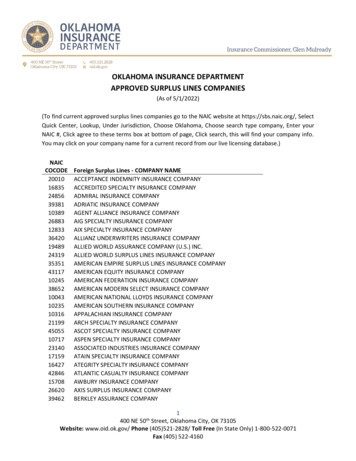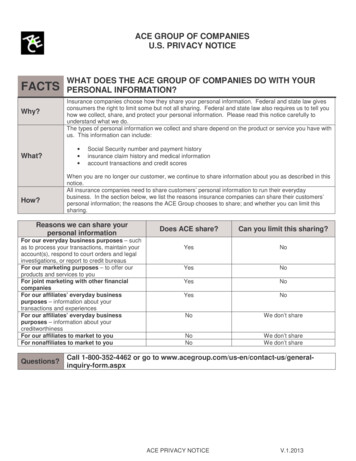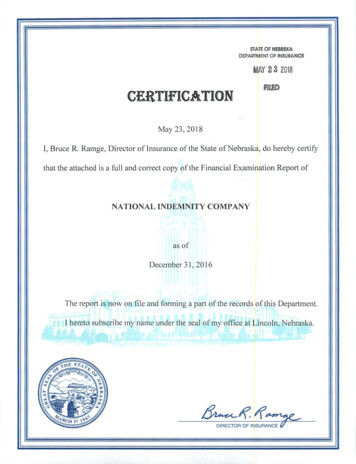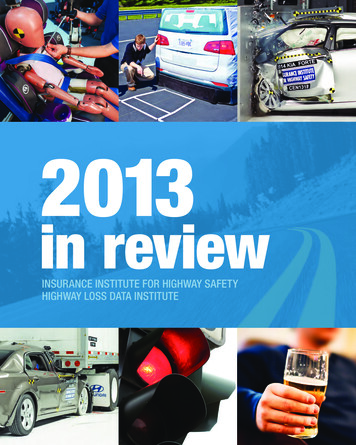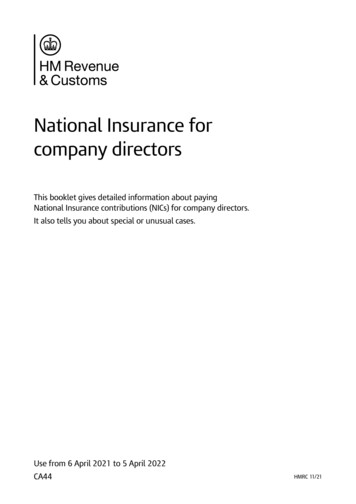
Transcription
National Insurance forcompany directorsThis booklet gives detailed information about payingNational Insurance contributions (NICs) for company directors.It also tells you about special or unusual cases.Use from 6 April 2021 to 5 April 2022CA44HMRC 11/21
Help and guidanceYou can get help and guidance from the following sources.The internetFor help with your payroll, go to www.gov.uk/business-tax/payeFor wider interactive business help, go to www.gov.uk/set-up-businessWebinarsWebinars are a way of learning about your payroll, such as ‘Getting payroll information right’.This webinar covers the most common errors that employees make when submitting informationto HMRC. It shows you how to provide accurate data and avoid common payroll mistakes.For more information about this and other webinars, go ng-peopleAny page printed from the online version of this helpbook is uncontrolled and may not be thelatest version. We recommend that you always check you’re referring to the latest online version.Online servicesFor information and help using our online services,go to www.gov.uk/log-in-register-hmrc-online-servicesFor more help with our online services, contact the helpline by: telephone: 0300 200 3600 textphone: 0300 200 3603Basic PAYE ToolsThe Basic PAYE Tools is software that you download onto your computer. It will help you run yourpayroll throughout the year. It’s designed for employers who have 9 or fewer employees, and youcan use it to calculate payroll deductions and then report payroll information online in real time.To find out more information about the Basic PAYE Tools and other HMRC recognised software,go to www.gov.uk/payroll-softwareEmployer helplinesIf you have: been an employer for less than 3 years, telephone 0300 200 3211 been an employer for 3 years or more, telephone 0300 200 3200 a hearing or speech impairment, textphone 0300 200 3212Tell us your employer PAYE and Accounts Office references when you contact us.You’ll find them on correspondence HMRC have sent to you.Employer helpbooks and formsHelpbooks and forms are available to download.Go to ions-for-employersYr laith GymraegI lawrlwytho ffurflenni a llyfrynnau cymorth Cymraeg, ewch i www.gov.uk/cymraeg sgroliwch i lawr i’rpennawd ‘Treth’ a dilynwch y cysylltiadau ‘Ffurflenni Cyllid a Thollau EM (CThEM)’ ac ‘Arweiniad athaflenni gwybodaeth CThEM’.Forms and guidance in Braille, large print and audioFor details of employer forms and guidance in Braille, large print or audio,phone the Employer Orderline on 0300 123 1074 and ask to speak to theCustomer Service Team.
Help and support from the Webinar Delivery TeamFind out more about our live and recorded webinars.Go to -peopleTo view our video clips, go to www.youtube.com/hmrcgovukHMRC Community ForumsHMRC Community Forums is for you and provides the help, support and guidance you need.Go to https://community.hmrc.gov.ukYou can ask questions, see what others are asking and get the answers and top tips you need to supportyou in running your business.Employer Bulletin onlineEmployer Bulletins contain information and news for employers. We publish these 6 times a year.Go to ustoms-employer-bulletinEmployer email alertsWe strongly recommend that you register to receive employer emails to prompt anddirect you to: each new edition or news about the Basic PAYE Tools the Employer Bulletin important new informationTo register, go to ubscriber/newIf you use PAYE OnlineRemember to keep your email address up to date. If you change your email address, updatePAYE Online to make sure you continue to receive email alerts when we’ve issued tax codesand other notifications.HM Revenue and CustomsIf you have a query about your PAYE scheme: phone the Employer Helpline on 0300 200 3500 write toPT Operations North East EnglandHM Revenue and CustomsBX9 1BXUnited KingdomTell us your employer PAYE and Accounts Office references when you contact us.You’ll find them on correspondence HMRC have sent to you.Your rights and obligations‘HMRC Charter’ explains what you can expect from us and what we expect from you.For more information, go to www.gov.uk/government/publications/hmrc-charter
ContentsIntroductionPage 1The rules for company directorsPage 2Alternative arrangements for the assessment ofdirectors’ National Insurance contributions (NICs)Page 2Applying the annual (or pro rata annual)earnings period rulesPage 7Directors’ earningsPage 10Working out NICsPage 12Paying NICs on accountPage 13More than one jobPage 14Change in category of NICs payablePage 18Recording NICs informationPage 23PAYE Online for employersPage 23Special circumstancesPage 24Statutory paymentsPage 28Quick guide to pro rata annual earnings periodsPage 29Alphabetical indexPage 30
Introduction1 About this bookletThis booklet: replaces the December 2020 edition of CA44, ‘National Insurance for company directors’ gives detailed information about the different National Insurance contributions (NICs) rules for company directors can also be used for employees who have annual or pro rata annual earnings periodsThe normal rules about NICs can be found in the CWG2(2021), ‘Employer Further Guide to PAYE and NICs’.Go to ere are legal requirements that mean employers must comply with their obligations.At the time of writing, this guide sets out HMRC’s view on how these legal requirements can be met.It will be updated annually and was last December 2020.All the examples in this booklet: use the 2021 to 2022 NICs rates and limits are for illustration purposes onlyIf you’re unhappy with our serviceFor information about our complaints procedures go to www.gov.uk/complain-about-hmrc2 Secondary NICs for employees under the age of 21From April 2015 the rate of employer Class 1 secondary NICs is 0% for employees under the age of 21 up to the‘Upper Secondary Threshold’ (UST). Class 1 secondary NICs continue to be payable on all earnings above this threshold.The current way in which NICs is assessed remains unchanged. Employers should make sure they hold the employee’scorrect date of birth. For more information read CWG2 Chapter 3, paragraph 2.8.5.2.1 Secondary NICs for apprentices under the age of 25From April 2016 the rate of Class 1 secondary NICs is 0% for apprentices under the age of 25 up to the‘Apprentice Upper Secondary Threshold’ (AUST).Apprentices must follow a government recognised apprenticeship in the UK, one which followsgovernment arrangements or approved frameworks, and have a written agreement, specifying thegovernment recognised apprentice framework or standard, with a start and expected completion date.This is an agreement between the training provider, apprentice and employer and will be the evidence theemployer needs to retain when applying the zero-rate of secondary Class 1 NICs for an apprentice under 25.Class 1 secondary NICs continue to be payable on all earnings above the AUST. The current way in which NICs isassessed remains unchanged. Employers should make sure that they hold the employee’s correct date of birth.For more information read CWG2 Chapter 3, paragraph 3.8.6.2.2 National Insurance contributions (NICs) Employment AllowanceFrom 6 April 2014, you may be eligible to claim an Employment Allowance of up to 4,000. The EmploymentAllowance is available for businesses, charities (including community amateur sports clubs) and certainemployers of care and support workers to offset against employer’s secondary Class 1 NICs liability.Subject to Parliamentary approval, from April 2020 the Employment Allowance will not be available toemployers who had qualifying Class 1 Secondary National Insurance contributions liabilities of 100,000or more in the previous year.You can claim the Employment Allowance as part of the normal payroll process through Real Time Information (RTI)or the Basic PAYE Tools.For more information, details of eligibility and how to claim the Employment Allowance,read CWG2 Chapter 3, paragraph 3.8.4 and go to www.gov.uk/claim-employment-allowance2.3 Apprenticeship LevyFrom April 2017 employers with annual pay bills greater than 3 million, and some connected companiesand charities with pay bill less than this amount, will be required to pay the Apprenticeship Levy.All employers (subject to the rules on connection) will have an annual levy allowance of 15,000 to offsetagainst their levy liability.This means that only employers with a pay bill of over 3 million will have to pay and report the levy.However, where the connection rules apply, a pay bill less than 3 million may attract a levy liability,depending on how the levy allowance is shared (connected companies and connected charities only havea single 15,000 levy allowance for the group). he levy is charged at a rate of 0.5% of an employer’s annual pay bill. Pay bill is defined as earnings which are liable toTClass 1 secondary NICs, including earnings below the Secondary Threshold. You’ll need to determine your levy liability.For more information read CWG2 Chapter 3, paragraph 3.8.7.Page 1
The rules for company directors3 IntroductionThis section describes what you need to know to work out NICs for company directors.4 Company directorsWho is a company director?For NI purposes, Regulation 1 of the Social Security (Contributions) Regulations 2001 defines a company director as: a member of a board or similar body where the company is managed by a board or similar body a single person where the company is managed by an individualOr, if a director as defined in either of the above is accustomed to acting under the instructions of another person,that person will be a director. This additional rule will not apply if the other person’s instructions are limited toprofessional advice, for example, the advice given by a solicitor.Directors of building societies which have not demutualised are not normally company directors for NICs purposes.What is a company director liable for?For NICs purposes, a company director is classified as an office holder.Under section 2(1) of the Social Security Contributions and Benefits Act 1992, (in Northern Ireland, section 2(1) of theSocial Security Contributions and Benefits (Northern Ireland) Act 1992) an office holder is liable for Class 1 NICs on earnings.5 What you should doTo assess NICs for company directors: use the correct NICs category letter for a director under the age of 21 – it’s the responsibility of the employerto make sure they hold the director’s correct date of birth and use the correct NI category letter use the correct NICs category letter for a director aged under 25 who is on an Approved Apprenticeship scheme –it’s the responsibility of the employer to make sure they hold the director’s correct date of birth and use thecorrect NICs category letter use an annual (or pro rata annual) earnings period to work out NICs work out NICs on the total earnings paid to the director each time a payment of earnings is made deduct the NICs already paid, if any, to arrive at the amount of NICs now due include all the director’s earnings when working out NICs, including fees and bonuses record NICs information on 1 payroll record unless this booklet tells you otherwise you can adapt the NICs tables to work out NICs (read paragraph 41 on page 13) you can use the exact percentage method to work out NICs (read paragraph 40 on page 12)AlternativelyYou can apply the arrangements for the assessment and payment of directors’ NICs outlined inparagraphs 6 to 9 (read pages 2 to 7).Alternative arrangements for the assessment of directors’ NICs6 How it worksFrom 6 April 1999 we’ve operated alternative arrangements for the assessment and payment of NICsfor company directors.Under Regulation 8 of the Social Security (Contributions) Regulations 2001, the earnings period for theassessment of directors’ NICs remains an annual one. But, subject to the qualifying conditions in paragraph 9(on page 7), you can, if you wish, make payments on account of directors’ NICs during the tax year based on theactual intervals of payment – usually weekly or monthly – in the same way as for other employees.If you do choose to pay NICs in this way you should apply the normal rules for assessing NICs, as set out in theCWG2(2020), ‘Employer Further Guide to PAYE and NICs’.7 Last payment of earnings in tax year (or directorship)Normally you should assess NICs using the shorter earnings period throughout the year until the last paymentof earnings in the tax year (or directorship) is being made (but read paragraph 8 on page 7).When the final payment of the director’s earnings in the tax year (or directorship) is being made, you must: reassess the NICs due on the director’s total earnings for the tax year on the basis of an annual(or pro rata annual) earnings period, as appropriate either deduct the amount of primary NICs then due from the payment or, if the earnings are insufficient tocover the primary NICs then due, pay the balance yourself adjust the final (or, if the director leaves or dies during the year, the next) remittance in the tax year to usto take into account the reassessmentPage 2
Remember, even if you use the weekly or monthly rates and limits to work out NICs throughout the year,because directors have an annual earnings period you must still reflect the annual or pro rata annual: Lower Earnings Limit (LEL) Primary Threshold (PT) Upper Earnings Limit (UEL) Upper Secondary Threshold (UST) Apprentice Upper Secondary Threshold (AUST)figures at the final reassessment. Under this particular arrangement, regardless of the method usedto work out NICs during the year, you can use either the exact percentage method or adapt the NICs tablesto work out the NICs at the final reassessment.Example for the 2021 to 2022 tax yearMr Armstrong is a director over the age of 21, is not an apprentice and receives a regular monthly salary of 1,615.An annual earnings period would normally apply for the assessment of NICs. However, as he’s paid monthly,a monthly earnings period can be used to assess NICs during the tax year.Monthly NICs dueLELSTPTUELUSTAUST 520 737 797 4,189 4,189 4,189EarningsDirector’s NICsCompany’s NICs 1,615 98.16 121.16Month 1Record the NICs details on the payroll record.By month 11 - NICs sNICs 1,079.76 1,332.76On the final payment of earnings in the tax year,reassess NICs on the total earnings received byreference to an annual earnings period and adjustthe final remittance to us accordingly.Total NICsletterA 17,765 2,412.52Month 12 - Based on an annual earnings period NICs due on 19,380NICsEarningsDirector’sCompany’sNICsNICs 1,177.44 1,454.52categoryTotal NICsEarnings: 1,615. Total earnings from the directorshipin the tax year (12 x 1,615) 19,380letterA 19,380 2,631.96NICs payable in month 12Director’s NICsCompany’s NICs 97.68( 1,177.44 – 1,079.76) 121.76( 1,454.52 – 1,332.76)In month 12 on the payroll record, you mustrecord the total earnings and NICs figures forthe year following the reassessment(not what falls to be due just for month 12).Mr Armstrong’s final Full Payment Submission (FPS) for the year would show:Data itemDescription79NI category79AGross earnings for NICs year to date79BGross earnings for NICs pay period 1,615.0082Earnings at the LEL year to date 6,240.0082AEarnings at LEL to PT year to date 3,328.00169Earnings at PT to UEL year to date 9,812.0086AEmployer NICs this pay period86AaEmployer NICs year to date86BEmployee NICs this pay period86BaEmployee NICs year to date84ADirector’s method of calculationA 19,380.00 121.76 1,454.52 97.68 1,177.44ALPage 3
Example for the 2021 to 2022 tax yearMr Taylor is a director under the age of 21, is not an apprentice and receives a regular monthly salary of 1,615.An annual earnings period would normally apply for the assessment of NICs. However, as he’s paid monthly,a monthly earnings period can be used to assess NICs during the tax year.Monthly NICs dueLELSTPTUELUSTAUST 520 737 797 4,189 4,189 4,189EarningsDirector’s NICsCompany’s NICs 1,615 98.16 0.00Month 1Record the NICs details on the payroll record.By month 11 - NICs sNICs 1,079.76 0.00On the final payment of earnings in the tax year,reassess NICs on the total earnings received byreference to an annual earnings period and adjustthe final remittance to us accordingly.Total NICsletterM 17,765 1,079.76Month 12 - Based on an annual earnings period NICs due on ICsNICs 1,177.44 0.00Total NICsEarnings: 1,615. Total earnings from the directorshipin the tax year (12 x 1,615) 19,380letterM 19,380 1,177.44NICs payable in month 12Director’s NICsCompany’s NICs 97.68( 1,177.44 – 1,079.76) 0.00( 0.00)In month 12 on the payroll record, you mustrecord the total earnings and NICs figures forthe year following the reassessment(not what falls to be due just for month 12).Mr Taylor’s final Full Payment Submission (FPS) for the year would show:Data itemDescription79NI category79AGross earnings for NICs year to date79BGross earnings for NICs pay period 1,615.0082Earnings at the LEL year to date 6,240.0082AEarnings at LEL to PT year to date 3,328.00169Earnings at PT to UEL year to date 9,812.0086AEmployer NICs this pay period 0.0086AaEmployer NICs year to date 0.0086BEmployee NICs this pay period86BaEmployee NICs year to date84ADirector’s method of calculationM 19,380.00 97.68 1,177.44ALPage 4
Example for the 2021 to 2022 tax yearMr Morris is a director over the age of 21, is not an apprentice and receives a regular monthly salary of 1,160.He’s also voted a bonus at the AGM on 3 June 2021 of 10,000 to be paid with his regular June salary.An annual earnings period would normally apply for the assessment of NICs. However, as he’s paid monthly,a monthly earnings period can be used to assess NICs during the tax year.Monthly NICs dueLELSTPTUELUSTAUST 520 737 797 4,189 4,189 4,189EarningsDirector’s NICsCompany’s NICs 1,160 43.56 58.37EarningsDirector’s NICsCompany’s NICs 11,160 546.46 1,438.37Month 1Record the NICs details on the payroll record.Month 3The 10,000 bonus should be included with thesalary of 1,160.By month 11 - NICs sNICs 982.06 2,022.07On the final payment of earnings in the tax year,reassess NICs on the total earnings by referenceto an annual earnings period and adjust the finalremittance to us accordingly.Total NICsletterA 22,760 3,004.13Month 12 - Based on an annual earnings period NICs due on ICsNICs 1,722.24 2,081.04Total NICsEarnings: 1,160. Total earnings from the directorshipin the tax year (12 x 1,160 10,000) 23,920letterA 23,920 3,803.28NICs payable in month 12Director’s NICsCompany’s NICs 740.18( 1,722.24 – 982.06) 58.97( 2,081.04 – 2,022.07)In month 12 on the payroll record, you mustrecord the total earnings and NICs figures forthe year following the reassessment(not what falls to be due just for month 12).Mr Morris’s final Full Payment Submission (FPS) for the year would show:Data itemDescription79NI category79AGross earnings for NICs year to date79BGross earnings for NICs pay period 1,160.0082Earnings at the LEL year to date 6,240.0082AEarnings at LEL to PT year to date 3,328.00169Earnings at PT to UEL year to date 14,352.0086AEmployer NICs this pay period86AaEmployer NICs year to date86BEmployee NICs this pay period86BaEmployee NICs year to date84ADirector’s method of calculationA 23,920.00 58.97 2,081.04 740.18 1,722.24ALPage 5
Example for the 2021 to 2022 tax yearMr Johnson is a director under the age of 21, is not an apprentice and receives a regular monthly salary of 1,160.He’s also voted a bonus at the AGM on 3 June 2021 of 10,000 to be paid with his regular June salary.An annual earnings period would normally apply for the assessment of NICs. However, as he’s paid monthly,a monthly earnings period can be used to assess NICs during the tax year.Monthly NICs dueLELSTPTUELUSTAUST 520 737 797 4,189 4,189 4,189EarningsDirector’s NICsCompany’s NICs 1,160 43.56 0.00EarningsDirector’s NICsCompany’s NICs 11,160 546.46 962.00Month 1Record the NICs details on the payroll record.Month 3The 10,000 bonus should be included with thesalary of 1,160.Record the details on the payroll record.By month 11 - NICs sNICs 982.06 962.00On the final payment of earnings in the tax year,reassess NICs on the total earnings by referenceto an annual earnings period and adjust the finalremittance to us accordingly.Total NICsletterM 22,760 1,946.46Month 12 - Based on an annual earnings period NICs due on ICsNICs 1,722.24 0.00Total NICsEarnings: 1,160. Total earnings from the directorshipin the tax year (12 x 1,160 10,000) 23,920letterM 23,920 1,722.24NICs payable in month 12Director’s NICsCompany’s NICs 740.18( 1,722.24 – 982.06)– 962.00( 0 – 962.00)In month 12 on the payroll record, you mustrecord the total earnings and NICs figures forthe year following the reassessment(not what falls to be due just for month 12).Mr Johnson’s final Full Payment Submission (FPS) for the year would show:Data itemDescription79NI category79AGross earnings for NICs year to date79BGross earnings for NICs pay period 1,160.0082Earnings at the LEL year to date 6,240.0082AEarnings at LEL to PT year to date 3,328.00169Earnings at PT to UEL year to date 14,352.0086AEmployer NICs this pay period86AaEmployer NICs year to date86BEmployee NICs this pay period86BaEmployee NICs year to date84ADirector’s method of calculationM 23,920.00– 962.00 0.00 740.18 1,722.24ALPage 6
8 W hat to do if the director receives a bonus or the category of NICs payablechanges during the yearIn many cases, directors will receive a bonus during the year. Waiting until the final payment of earnings to carryout the reassessment could lead to a disproportionate amount of primary NICs being payable at the year end.You can, if you wish, carry out the reassessment at the time of the change. However, you must then continue to use theappropriate annual (or pro rata annual) earnings period rules, as described in this booklet, for the rest of that tax year.9 Qualifying conditions for the alternative arrangementsYou’ll be able to take advantage of this arrangement if: the director agrees to NICs being assessed in this way the director normally receives his earnings in a payment pattern for which a regular earnings periodcan be established for the assessment of NICs those payments normally exceed the LEL for the pay period concernedApplying the annual (or pro rata annual) earnings period rules10 E arnings limits, Primary Threshold (PT), Secondary Threshold (ST), Upper Earnings Limit(UEL), Upper Secondary Threshold (UST) and Apprentice Upper Secondary Threshold (AUST)Both the director and the company are liable for Class 1, that is, employed-earners NICs when the director’stotal earnings reach the Lower Earnings Limit (LEL). But the director only pays NICs if the director’s total earningsexceed the Primary Threshold (PT) and the company only pays NICs if the director’s total earnings exceedthe Secondary Threshold (ST).The company and the director pay NICs at the appropriate percentage rate on all earnings above the ST and PTrespectively, up to and including the Upper Earnings Limit (UEL), the Upper Secondary Threshold (UST) for thosedirectors under the age of 21 or the Apprentice Upper Secondary Threshold (AUST) for those directors who areapprentices under the age of 25.If the director’s total earnings reach or exceed the UEL/UST/AUST, the director pays NICs only at a rate of 2%on any earnings which exceed the UEL/UST/AUST. The company pays NICs at the appropriatepercentage rate on all earnings above the ST, including those which exceed the UEL/UST/AUST.The annual earnings limits and thresholds are the same as for other employees.For more information about National Insurance rates and thresholds, go to www.gov.uk/national-insurance-rates-letters11 Lower Earnings Limit (LEL)If the director has: an annual earnings period, do not record the earnings details for NICs purposes until the director’stotal earnings for the tax year reach or exceed the annual LEL a pro rata annual earnings period, do not record the earnings details for NICs purposes until thetotal earnings paid to the director since the date of appointment reach or exceed the pro rata annual LELRead paragraph 6 on page 2 for information about alternative arrangements for the assessment of director’s NICs.Read paragraph 25 on page 9 to work out pro rata annual earnings limits, ST, PT and UEL/UST/AUST.12 Secondary Threshold (ST)If the director has: an annual earnings period, no NICs are due from the company until the director’s total earningsfor the tax year exceed the annual ST a pro rata annual earnings period, no NICs are due from the company until the total earningspaid to the director since the date of appointment exceed the pro rata annual STRead paragraph 25 on page 9 to work out pro rata annual earnings limits, ST, PT and UEL/UST/AUST.13 P rimary Threshold (PT)If the director has: an annual earnings period, no NICs are due from the the director until the director’s total earningsfor the tax year exceed the annual PT a pro rata annual earnings period, no NICs are due from the director until the total earningspaid to the director since the date of appointment exceed the pro rata annual PTRead paragraph 25 on page 9 to work out pro rata annual earnings limits, ST, PT and UEL/USTAUST.Page 7
14 When total earnings exceed the Secondary Threshold (ST)When the total earnings in the tax year or pro rata period exceed the ST, the company pays NICson those earnings which exceed the ST.From April 2015, a secondary rate of 0% was introduced for those directors under the age of 21 with earningsbetween the ST and the UST. The secondary rate of 0% also applies from April 2016 to directors who areapprentices aged under 25 with earnings between the ST and AUST.15 When total earnings exceed the Primary Threshold (PT)When the total earnings in the tax year or pro rata period exceed the PT, the director pays NICs on thoseearnings which exceed the PT.16 Upper Earnings Limit (UEL)The director pays NICs on all earnings above the PT up to and including the employee’s annual(or pro rata annual) UEL, but only at a rate of 2% on those earnings which exceed the UEL.For those directors above the age of 21, the company pays NICs at the appropriate percentage rateon all earnings above the ST, including those which exceed the UEL.Read paragraph 25 on page 9 to work out pro rata annual earnings limits, ST, PT and UEL/UST/AUST.16.1 Upper Secondary Threshold (UST)For those directors under the age of 21, the company pays secondary NICs at the rate of 0% on earningsbetween the ST and the UST. The standard rate of 13.8% will continue to be paid on earnings above the UST.There is no change to the director’s primary NICs.Read paragraph 25 on page 9 to work out pro rata annual earnings limits, ST, PT and UEL/UST/AUST.16.2 Apprentice Upper Secondary Threshold (AUST)For those directors who are apprentices under the age of 25, the company pays secondary NICs at the rate of 0% onearnings between the ST and the AUST. The standard rate of 13.8% will continue to be paid on earnings above the AUST.There is no change to the directors primary NICs.Read paragraph 25 on page 9 to work out pro rata annual earnings limits, ST, PT and UEL/UST/AUST.17 National Insurance contributions ratesThe percentage rates you use to work out director’s NICs depend on a number of factors.The director’s NICs, if any, depend on: the director’s age whether the director has a married woman’s or widow’s electionFor more information about National Insurance rates and thresholds go loyers-2021-to-202218 Directors paying reduced rate NICsIf the director is a married woman or widow who’s entitled to pay reduced rate NICs and wants to continuepaying at a reduced rate, she pays NICs at the reduced rate on all earnings above the annual (or pro rata annual) PTup to and including the annual (or pro rata annual) UEL. But she still pays at a rate of 2% on these earnings whichexceed the UEL. For these directors you must hold one of these valid forms: CA4139 CF383 Certificate of Election CF380A Certificate of Reduced Liability19 Directors over State Pension ageIf earnings are paid or are due to be paid on or after State Pension age, the director pays no NICs.You’ll need to obtain sight of the director’s birth certificate or passport as evidence of their date of birth,both of which can be copied and kept on file as proof that Class 1 NICs are not payable.20 Company’s NICsThe director and company pay NICs at the appropriate standard percentage rate.If the director: pays reduced rate NICs, the company pays NICs as normal at the appropriate percentage rate is over State Pension age, the company pays NICs at the appropriate percentage rate is under the age of 21, the rate of secondary NICs is 0% between the ST and the UST is an apprentice under the age of 25, the rate of secondary NICs is 0% between the ST and the AUSTPage 8
21 E arnings periodsThe interval at which employees are paid is usually the earnings period but directors are different.Even if the directors are paid weekly or monthly, their earnings period is either: annual pro rata annual22 Annual earnings periodA person who
The rules for company directors Page 2 Alternative arrangements for the assessment of . directors' National Insurance contributions (NICs) Page 2 Applying the annual (or pro rata annual) earnings period rules Page 7 Directors' earnings Page 10 Working out NICs Page 12 Paying NICs on account Page 13 More than one job Page 14







